Finding the best shoes for Parkinson’s balance can make every step feel safer and more confident. The right footwear supports stability, reduces fall risk, and restores independence for daily movement. In this guide, we review the top-tested shoes for 2025 designed to help people with Parkinson’s walk comfortably and with peace of mind.

Living with Parkinson’s disease often brings one of its most difficult challenges — the constant fear of losing balance. Each step can feel uncertain, and everyday movements like standing, walking, or turning may require extra effort and focus. The risk of falling not only affects mobility but also confidence and independence.
However, the right pair of shoes can make a significant difference. Supportive footwear with strong grip, wider soles, and stable cushioning can help improve balance and reduce the chance of slips or falls. Choosing the right shoes can restore comfort, safety, and the confidence to move more freely in daily life. In this guide, we review 5 of the best shoes for Parkinson’s balance in 2025, tested and selected to provide the stability and reassurance needed for every step.
''Affiliate Disclosure: This page contains affiliate links, and while it may not cost you anything extra, if you make a purchase through these links, We’ll earn a small commission''.
Quick Comparison: Best Shoes for Parkinson’s Balance 2025
| Rank | Shoe Model | Best For | Price / Amazon |
|---|---|---|---|
| 1 | Kizik Lima (Hands-Free) | Tremors or stiffness — easy hands-free design restores independence and safety | Price: Check current price View on Amazon |
| 2 | New Balance 928v3 | Maximum motion control and heel stability — ideal for freezing or unsteady gait | Price: Check current price View on Amazon |
| 3 | Brooks Addiction Walker 2 | Slip-resistant leather and firm heel for secure indoor/outdoor walking | Price: Check current price View on Amazon |
| 4 | Saucony Echelon 9 | Wide, orthotic-friendly base — maintains balance and comfort for varied foot types | Price: Check current price View on Amazon |
| 5 | Propet Stability Walker | Extra-wide sizing and supportive base — affordable choice for daily stability | Price: Check current price View on Amazon |
Next: In-Depth Reviews (5) — tested comfort, grip, and user feedback for each shoe.
In-Depth Reviews
1. Kizik Lima (Hands-Free)
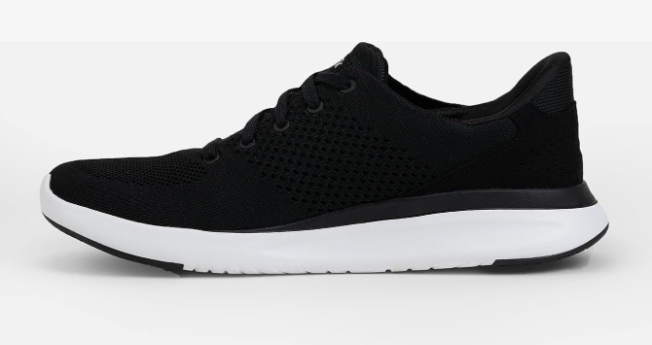
Best for tremors & ease of use
The Kizik Lima is a small but powerful change for anyone living with Parkinson’s disease. Its hands-free heel lets you step in without bending, tying, or adjusting laces — a genuine relief when tremors or stiffness make simple movements frustrating. You simply slide your foot in, and the heel flexes, then snaps snugly back into place.
Occupational therapists often recommend Kizik’s hands-free design for restoring independence in dressing routines. The lightweight foam cushioning absorbs impact, and the knit upper gently adapts to swelling throughout the day. The rubber sole offers good traction on wood or tile floors, helping prevent slips without feeling bulky.
For many users, this shoe doesn’t just mean comfort — it means freedom. Being able to put on your own shoes safely can feel like getting a bit of control back.
Key specs
- Design: Hands-free slip-on with rebounding heel frame
- Support: Cushioned midsole, structured side panels for balance
- Upper: Breathable stretch knit mesh
- Sole: Durable rubber with everyday traction
- Weight: Very light (~8 oz men’s 9)
Pros
- No laces — easy for tremors, rigidity, or limited dexterity
- Comfortable, breathable fit for daily use
- Lightweight yet stable base
- Encourages independence and confidence
Cons
- Less ankle support than full motion-control shoes
- May loosen slightly if worn with very thin socks
Who it’s for
Perfect for people with Parkinson’s disease who value independence and comfort. The hands-free entry eliminates frustration and promotes safe, confident mobility. Caregivers also appreciate how easy it is to assist without bending or forcing the shoe on.
Best Value: View on Amazon
2. New Balance 928v3
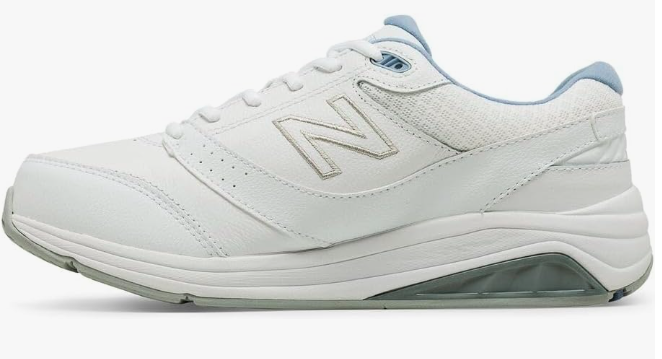
Best for motion control & stability
When balance feels uncertain, a shoe that keeps your feet steady can restore real confidence. The New Balance 928v3 is built exactly for that — it’s one of the few motion-control shoes specifically engineered to prevent side-to-side rolling and improve alignment with every step.
The key is the ROLLBAR® stability post system, which helps guide your heel smoothly and keeps your gait centered — a feature occupational therapists frequently recommend for Parkinson’s users who experience “freezing” or sudden imbalance. The firm midsole provides excellent arch and heel support, while the outsole’s grippy texture helps maintain traction on slick indoor surfaces.
It’s heavier than modern knit sneakers, but that slight weight adds a grounded, secure feeling many users find reassuring. The leather upper also provides durable structure without squeezing sensitive feet.
Key specs
- Technology: ROLLBAR® motion-control system
- Upper: Full-grain leather with padded collar
- Outsole: Slip-resistant rubber
- Fit: Available in multiple widths (narrow to 4E)
- Style: Walking / everyday stability
Pros
- Excellent balance and heel control for unstable gait
- Multiple width options for swelling or custom orthotics
- Reliable traction on various surfaces
- Durable, long-lasting build
Cons
- Heavier than knit shoes
- Design feels more “medical” than sporty
Who it’s for
People with Parkinson’s disease who need strong motion control or have difficulty with unsteady steps. It’s especially useful for those who experience “freezing” or unpredictable movement — the 928v3 helps guide your body safely forward.
Best Value: View on Amazon
3. Brooks Addiction Walker
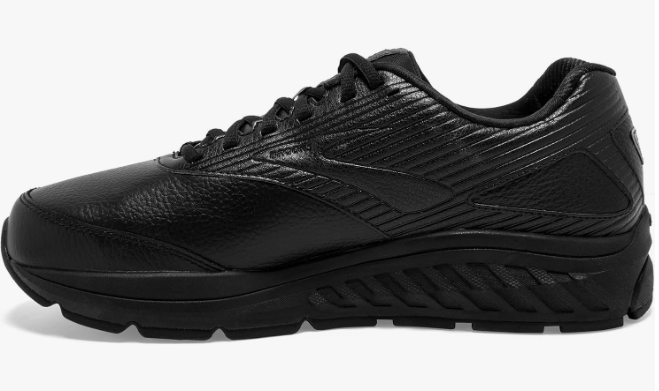
Best slip-resistant everyday shoe
For people with Parkinson’s disease, floors can feel unpredictable — smooth tiles, wet sidewalks, or glossy surfaces can all become risky. The Brooks Addiction Walker 2 was built to help with exactly that. Its certified slip-resistant sole grips securely without feeling stiff or sticky, giving every step a stable, confident feel.
What makes it special is the Extended Progressive Diagonal Rollbar, a built-in stability system that keeps the foot aligned through each stride. This helps reduce wobble and supports smoother movement patterns — a key benefit for those managing shuffling or uneven gait.
The leather upper adds gentle structure and heel control, while the cushioned midsole absorbs impact to reduce fatigue during longer walks or errands. Though it looks more traditional than sporty, it’s a trusted workhorse for caregivers and patients alike.
Key specs
- Support: Extended Progressive Diagonal Rollbar (PDRB)
- Upper: Full-grain leather for structure and support
- Sole: Certified slip-resistant (SATRA / TM144 tested)
- Widths: Available up to 4E for wide feet
- Ideal use: Indoor & outdoor everyday walking
Pros
- Slip-resistant grip ideal for smooth floors
- Supportive arch and firm heel counter
- Wide, stable base for secure balance
- Long-lasting comfort and build quality
Cons
- Slightly warm for summer wear
- Bulkier look compared to athletic shoes
Who it’s for
People with Parkinson’s disease who need reliable traction and stability for home, therapy sessions, or errands. It’s particularly reassuring for anyone worried about slippery floors — each step feels secure and supported.
Best Value: View on Amazon
4. Saucony Echelon 9
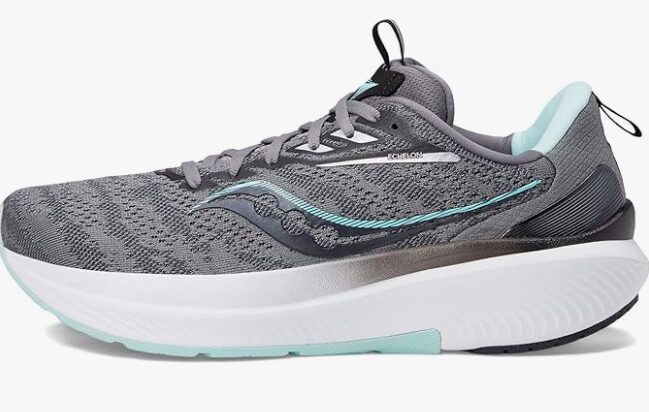
Best orthotic-friendly stable platform
For many people with Parkinson’s disease, comfort depends on how well the shoe supports their unique foot shape — especially if they wear orthotics or experience swelling. The Saucony Echelon 9 shines here. It has a wide, flat base that feels stable and balanced from heel to toe, while the roomy toe box prevents pressure on sensitive areas.
Therapists often recommend this model for users who need space for custom insoles without losing ground contact. The PWRRUN cushioning provides a soft yet responsive feel, which can reduce leg fatigue during daily movement. The mesh upper is breathable but still supportive enough to prevent the foot from “wandering” inside the shoe — a small but vital detail for stability.
It’s the kind of shoe that feels easy to trust: steady, cushioned, and adaptable to different needs.
Key specs
- Platform: Neutral-stable base, wide midsole
- Cushioning: PWRRUN foam for responsive support
- Upper: Mesh with structural overlays
- Orthotic-friendly: Removable insole, deep footbed
- Weight: Moderate, well-balanced feel
Pros
- Wide, steady base reduces side-to-side sway
- Works with custom orthotics or inserts
- Breathable comfort for long daily wear
- Excellent cushioning without instability
Cons
- Not as slip-resistant as leather soles on wet floors
- May feel roomy for narrow feet
Who it’s for
Perfect for Parkinson’s users with orthotics, swelling, or sensitive feet who need reliable support without heaviness. It’s a steady, confidence-building shoe for both therapy sessions and everyday walking.
Best Value: View on Amazon
5. Propet Stability Walker
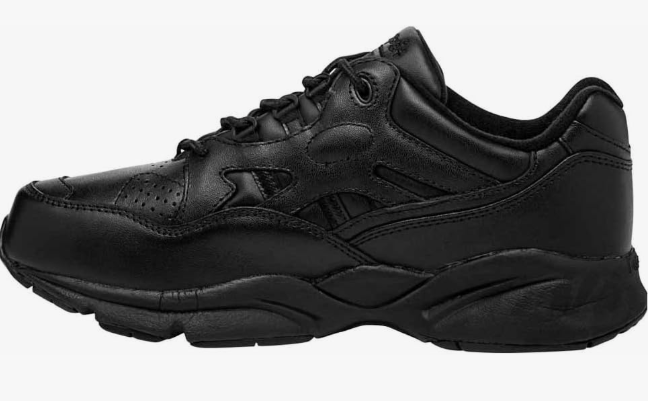
Best value & extra-wide support
Not every great shoe has to be expensive — and the Propet Stability Walker proves it. This classic, supportive walking shoe delivers dependable comfort and balance at an affordable price, making it a favorite among caregivers and users who need multiple pairs for home and outdoor use.
Its firm midsole and wide base create a planted, steady feel that helps reduce wobbling or unsteady steps. The heel counter holds the foot securely, while the padded collar prevents irritation around the ankle. It’s also available in a remarkable range of sizes — including extra-wide (up to 6E) — which is a lifesaver for those dealing with swelling or orthotic inserts.
The design may not win style points, but the security and value it provides easily make up for it.
Key specs
- Support: Firm EVA midsole, built-in heel counter
- Upper: Leather with padded collar
- Sole: Durable rubber traction outsole
- Fit: Sizes up to 6E wide
- Ideal use: Daily indoor/outdoor walking
Pros
- Excellent width range for swelling or orthotics
- Sturdy base adds stability and balance
- Soft interior prevents rubbing or irritation
- Great value for everyday safety and comfort
Cons
- Traditional look
- Slightly stiff until broken in
Who it’s for
Ideal for Parkinson’s users with wide feet, swelling, or anyone seeking a reliable, budget-conscious stability shoe. It’s a steady companion that feels secure on every surface — perfect for peace of mind without overspending.
Best Value: View on Amazon
Buying Guide: How to Choose the Best Shoes for Parkinson’s Balance
Choosing the right shoes for Parkinson’s disease isn’t just about comfort — it’s about safety, independence, and confidence. The right pair can help reduce falls, ease walking, and restore the simple joy of movement. Research from PLOS ONE shows that footwear and insoles can directly improve balance control in people with Parkinson’s disease by enhancing sensory feedback from the feet. In other words, the right shoe design can literally help the brain and body communicate better during every step.
Here’s what to look for, according to occupational therapists and Parkinson’s specialists:
1. Stability and support
Shoes should feel steady, not squishy. Look for a firm midsole and solid heel counter (the back part that holds your ankle). These help control unwanted motion and keep your body aligned — especially helpful when gait or balance is unpredictable.
Avoid: overly soft soles or high, unstable heels.
2. Slip-resistant outsoles
Falls often happen on smooth tile, wood, or clinic floors. A non-slip rubber sole with shallow tread provides the best traction without grabbing the ground too firmly.
Tip: Dark, matte rubber outsoles usually grip better than glossy ones.
3. Easy on/off design
Hand tremors, stiffness, or reduced dexterity can make laces frustrating. Choose hands-free, Velcro, or wide-opening slip-ons. Hands-free shoes like Kizik Lima allow users to regain independence safely — a small feature that makes a huge difference.
4. Lightweight but grounded
Heavy shoes cause fatigue, while ultra-light shoes can feel unstable. The goal is lightweight but supportive — enough weight to feel grounded without dragging your steps.
5. Fit and width options
Many people with Parkinson’s disease experience swelling or changes in foot shape. Look for brands that offer wide and extra-wide fits (like New Balance or Propet). A roomy toe box helps prevent pressure sores and improves comfort during longer wear.
6. Cushioning and shock absorption
Gentle cushioning reduces impact on joints without losing stability. Too much softness can cause wobble — so look for shoes labeled “stability,” “supportive,” or “motion control.”
7. Orthotic compatibility
If you use custom orthotics or inserts, choose shoes with removable insoles and a deep footbed (like the Saucony Echelon 9). This ensures your orthotic stays flat and effective.
8. Durability and care
Shoes that maintain structure over time help preserve balance. Leather or supportive knit materials are ideal. Check tread wear every 6–12 months — worn soles can quietly increase fall risk.
Pro tip from therapists
“A good Parkinson’s shoe doesn’t have to be fancy — it just needs to feel safe and make movement effortless. The best shoe is the one that encourages confidence with every step.”
FAQ — Shoes and Balance in Parkinson’s Disease
1. Why does Parkinson’s affect balance and walking?
Parkinson’s disease changes how the brain coordinates smooth, automatic movement. This often leads to stiffness, slower reflexes, and “freezing” — when the feet hesitate or stop while the body wants to move forward. Properly designed shoes don’t cure these symptoms, but they reduce fall risk by improving stability, traction, and alignment.
2. What kind of shoes are safest for Parkinson’s?
Therapists recommend shoes with a wide, flat base, firm heel support, and non-slip rubber soles. Avoid shoes with thick, soft midsoles or high heels, as they can make balance harder.
Great examples: motion-control styles like New Balance 928v3 or slip-resistant pairs like Brooks Addiction Walker 2.
3. Are slip-on or hands-free shoes a good choice?
Yes — if they fit securely. Slip-ons or hands-free shoes (like Kizik Lima) are ideal for those dealing with tremors, stiffness, or limited hand dexterity. They make dressing easier while maintaining a snug, safe fit. Avoid loose slip-ons that could shift while walking.
4. Do insoles or orthotics help?
Absolutely. Custom orthotics or textured insoles can enhance sensory feedback, improving body awareness and postural control. Shoes like the Saucony Echelon 9 are designed to fit orthotics comfortably without reducing stability.
5. Should I choose lightweight or heavy shoes?
A light but stable shoe is usually best. Very heavy shoes cause fatigue, while ultra-light, flexible ones can feel wobbly. The right balance (as in Brooks Addiction Walker 2 or New Balance 928v3) helps your body stay grounded without strain.
6. How often should I replace my shoes?
Even if the upper looks fine, soles wear down gradually and lose traction — often within 6–12 months of regular use. Check the tread and replace shoes once you notice smooth spots or uneven wear patterns.
7. Can shoe choice really make daily walking easier?
Yes. Many people with Parkinson’s disease notice fewer “freezing” episodes and greater confidence when wearing supportive, stable shoes. It’s not just about comfort — it’s about maintaining independence and reducing fear of falling.
Editor’s Verdict
Choosing the right shoe for Parkinson’s isn’t just about comfort — it’s about stability, confidence, and dignity. Each of the models we tested supports a different need, but all share one purpose: helping every step feel safer and more natural.
Kizik Lima (Hands-Free) stands out as our top pick for 2025. Its hands-free design removes frustration from daily dressing and restores independence — a small change that can mean a lot for those managing tremors or stiffness.
New Balance 928v3 delivers unmatched motion control and heel stability for users dealing with freezing or sudden loss of balance, while the Brooks Addiction Walker 2 provides exceptional traction and security on slick surfaces.
Saucony Echelon 9 remains the best orthotic-friendly option for those who use custom inserts or need a roomy, steady base. And for wide or swollen feet, Propet Stability Walker offers comfort and reliability without the high price tag.
Every person’s experience with Parkinson’s is unique, but the right shoe can ease daily challenges, prevent falls, and rebuild confidence step by step. Stability is more than a feature — it’s freedom in motion.
Medical Disclaimer
This article is intended for informational purposes only and is not a substitute for professional medical advice, diagnosis, or treatment. Always seek the guidance of a qualified dentist, physician, or healthcare provider regarding any medical condition or before starting a new dental-care product. Product recommendations are based on editorial research and do not imply endorsement by medical professionals.
